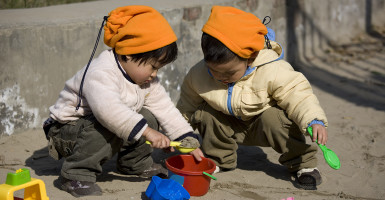China is abandoning its controversial “one-child policy” in favor of a universal two-child policy, according to Chinese news agency Xinhua. The move comes after several years of the Chinese government slowly relaxing the 35-year-old mandate.
The most recent policy modification came last year, when Chinese men and women who are only children were told that they could apply for a second birth permit, the government-issued allowance necessary for pregnancy.
The two-child policy announcement comes after a four-day-long meeting between the Communist Party’s Central Committee officials in Beijing. The meeting’s communiqué, or minutes, offer insight into the decision.
“Improve the demographic development strategy,” the document reads according to the New York Times. “Comprehensively implement a policy that couples can have two children, actively taking steps to counter the aging of the population.”
In effect, the shift signals a Chinese acknowledgement of the country’s aging labor force and essential demographic crisis.
“China has been struggling economically, and I think it’s more revealing in terms of what they’re really worried about, which is their economy, instead of any sort of attempt to help their people,” says Olivia Enos, a research associate with The Heritage Foundation’s Asian Studies Center.
Indeed, China has a long history of manipulating fertility, ranging from the “longer, later, fewer” policies of the late 1970s, which encouraged fewer births, to Mao Zedong’s practice of rewarding population expansion with food incentives in an attempt to ensure Chinese dominance.
According to Enos, the Chinese workforce has decreased by an estimated 35 percent at the same time as China’s aging population has increased by roughly 60 percent, as a result of the one-child policy.
Moreover, due to the advent of sex-selective abortion, China has an “excess” of roughly 17 million marriage-aged men who lack a female counterpart, according to Sarah Torre, a policy analyst for The Heritage Foundation’s Institute for Family, Community, and Opportunity.
“If those men aren’t settling down and getting married, they’re not having a first, let alone a second, child,” Torre says, adding that the demographic catastrophe has also led to an increase in sex and bride trafficking of women from surrounding nations, in addition to the reported human rights abuses enacted against China’s own people by the Chinese government.
According to Torre, those abuses include forced abortion and sterilization, enacted by China’s “500,000-person family planning control apparatus.”
While it remains to be seen if the policy overhaul will produce long-term intended results–including a growing working and female population—a glimpse into the future has perhaps been offered by those certain Chinese communities, usually rural, who have been allowed to have two children in recent years and have seemingly chosen not to do so.
“Part of the reason I would imagine China has done this is because their earlier tweak to the policy a couple years ago allowing only children to have two children didn’t produce many additional births,” Torre says, estimating that that change contributed an additional one million within the context of 16 million births annually.
While a Chinese migration out of rural areas and into expensive cities could be a deterrent for having a second child, Enos offers another take.
“When you’re told for so many years that one child is the ideal, at some point, you’re probably going to buy it,” she says. “Why would it one day be the most ideal thing ever, and then the next day not? To some extent it’s just a revelation of the fact that the propaganda worked.”
“China just needs to get out of the family business, period,” she adds.

























